

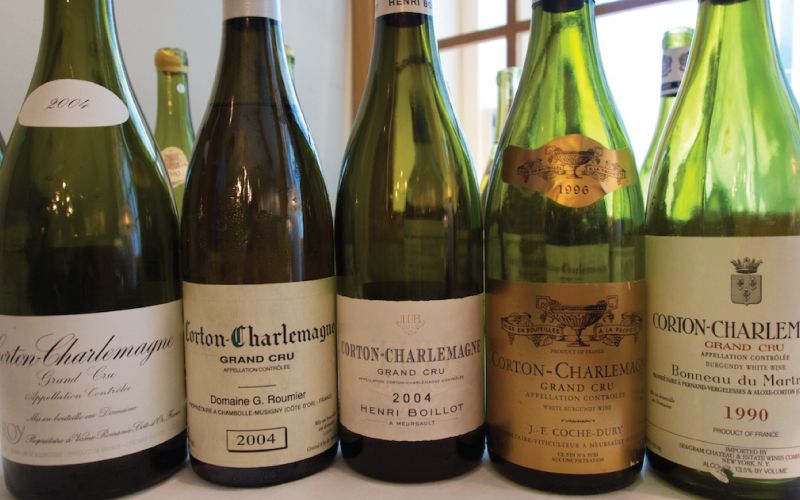
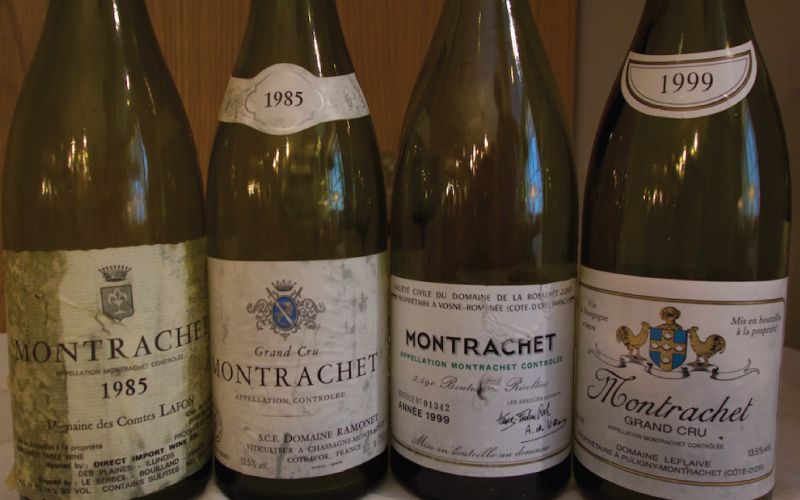
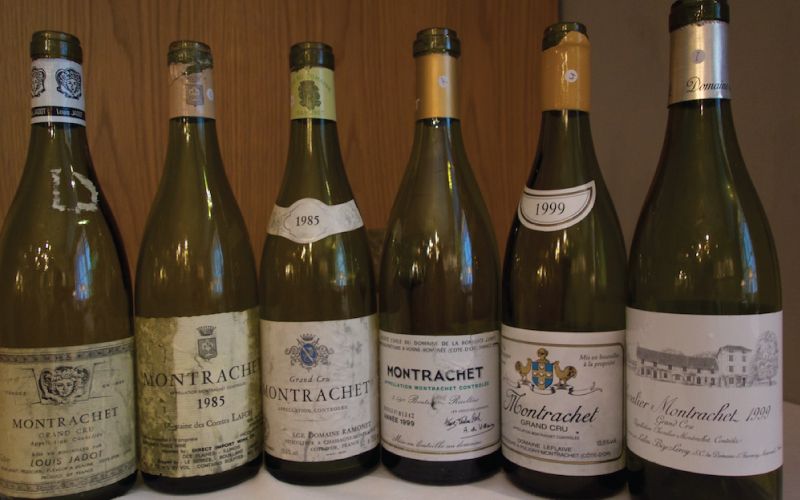
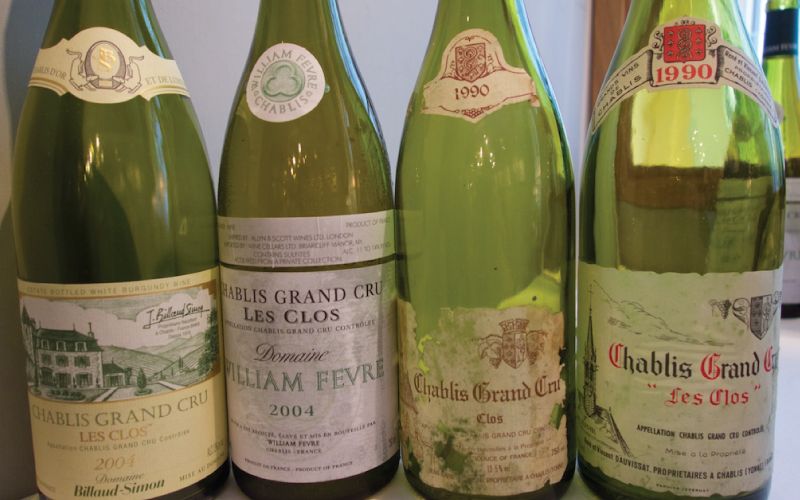
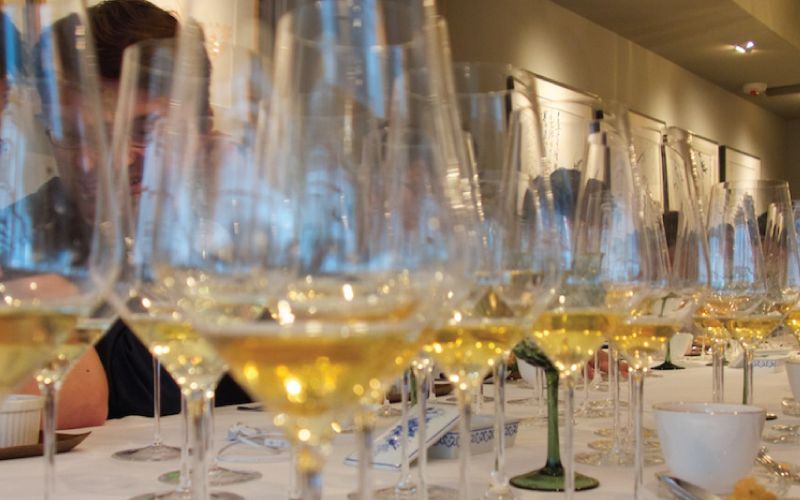
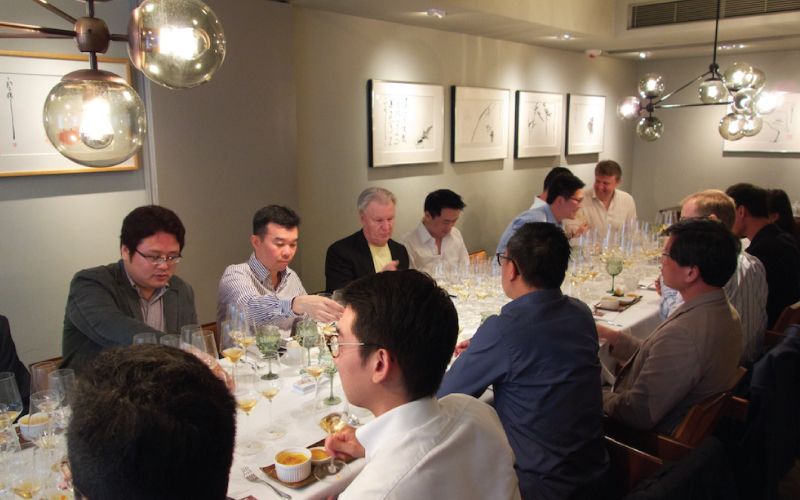
IntroductionThe smallest event of the five that we organized over the two days we hosted with Allen Meadows was a “best of the best” white Burgundy lunch at Duddell’s on the Sunday. ‘Hair of the dog’ perhaps after the excesses of the night before at the gala dinner, but it seemed to do the trick. Quality is a great restorative! White Burgundy can be as perfunctory as wine from any region, but it can also reach the exalted heights that nudge fine wine perfection. Our attempt today was to search out those wines through the lens of three of its best, but contrasting, terroir: Chablis Les Clos |
|
Some vineyard context from Allen MeadowsAllen gave us a highly-informed overview of the special nature of each of these grands crus appellations as we tasted. Chablis Les Clos, he explained, is today regarded as the top vineyard of Chablis. (Vaudésir was in the past, because of its amphitheatre aspect to capture the sun, but that was before the region got warmer). He felt that the mark of true Chablis was so strong that after tasting a few bottles, it is the region you would have the least difficulty in identifying blind. I’ve often thought so too at premier cru level, but sometimes at the top grand cru level it is much harder to tell in my view. The Dauvissat was so screamingly Chablis I think many tasters would have picked it, but the exceptionally ripe nature of the Billaud-Simon and the Raveneau, I think could easily have tripped me up and put me in the Côte de Beaune. In wines like that, the distinct saline/sea smell of Chablis is either missing, or pushed to the background. Allen gave a detailed description of the breakdown of Corton-Charlemagne, which I won’t repeat here, lest to say that a hill that straddles three villages, and that Corton- Charlemagne covers a very wide range of expositions. That means that where a domaine’s Corton-Charlemagne is planted will have a large bearing on its style, and that some holdings will better suit warmer, and others cooler, vintages. It’s an entire study in itself! That perhaps goes some way to explaining why “Corton-Charlemagne” never quite conjures a coherent picture in my mind in the way that Montrachet does. I think another is that the first two that pop into my head when Corton-Charlemagne is mentioned as such different wines – Coche-Dury, which is a signature wine to an extent that it can be spotted blind as Coche-Dury it is so aromatic, concentrated and intense; and Bonneau du Martray, which always conveys itself with great elegance and finesse, even in a bold vintage like 1990. Generally, I tend to think of Corton-Charlemagne in the vein of the Bonneau du Martray style – refined, elegant, but I know many fans associate the vineyard with Coche Dury, and with Domaine Leroy, another producer of a very intense, rich style. In Montrachet we find more homogeneity. Allen explained that, broadly speaking, we can divide Montrachet down its existing division between the Puligny-side (more refined and elegant), and the Chassagne-side (more body, but less refinement), but that there are other differences. Allen made the point that great Burgundy achieves great power without heaviness. It’s a point I often consider, and sometime make, especially in relation to the reds, but it holds too for the whites – especially Montrachet. Many times when drinking Montrachet I note the power, the concentration, and length, but seldom do I note heaviness. This is in contrast to many chardonnay wines made elsewhere, where power is usually closely aligned to alcohol and heaviness. One final note, prior to the tasting notes: “premox” (or premature oxidation) is a major problem since around the mid-1990s. It ruins quite a large proportion of these wines, and we had to discard and substitute a number of bottles from this lunch because of it. My notes on that subject are appending to the end of this report. But first, the good news… |
|
2004 Chablis Les Clos, Domaine Billaud-Simon (LW 92)Fine pale lemon gold; surprisingly sweet nose – touch of fresh pineapple, flowers; fine, taut mineral acidity well covered by precocious sweet fruit, lovely rounded ripe acidity. Fairly long finish. Very nice. I’m not sure I would pick this as Chablis tasting it blind. |
|
2004 Chablis Les Clos, Domaine William FèvreOur bottle was badly “premoxed” (premature oxidation). So was the back up bottle. |
|
2004 Corton-Charlemagne, Domaine Leroy (LW 95)Fine pale gold; toasty, buttered popcorn nose, a touch of earth, there is some sweetness on the nose but the impression overall is distinctly savoury/umami; concentrated on the palate, pure, essency intensity, with a citrus core, creamy, slighty oily texture, nutty oak, ripe, generous, yet focused and well delineated. Very Leroy. |
|
2004 Corton-Charlemagne, Domaine G. Roumier (N/R)Our bottle was badly “premoxed”. We opened a bottle of the 1999 of the same wine, and it was also badly premoxed. So we opened an Henri Boillot… |
|
2004 Corton-Charlemagne, Henri Boillot (LW 93)Solid lemon gold appearance; ripe, honeyed, fresh cereals, citrus and nut nose; mouthcoating, fairly concentrated, creamy with great acid snap, very long finish. Superb. |
|
1990 Chablis Les Clos, Domaine Dauvissat (LW 98)Very bright mid-gold; sweet, quite earthy mineral nose that continued to expand in the glass, very terroir oyster-shell mineral, saline; juicy, spicy, with intense acidity that initially left this quite tightly wound up in the glass, but it unfurled to reveal incredible extract, great purity, oyster-shell and saline minerality, citrus, and great length. This is quite rich, but very pure in expression. My wine of the lunch. 8 out of 34 votes for wine of the lunch – 3rd top wine overall. |
|
1990 Chablis Les Clos, Domaine Raveneau (LW 94)Bright full gold; fresh ripe nose, touch floral and even a slight sense of botrytis; ample on the palate, fresh still, packed with flavor, floral, and a touch of tropical fruit. Seems later picked and more luscious in style next to the Dauvissat. This conveys an effortless style, lovely flowing texture in the mid-palate, fresh and heathery. Delicious. Very fine. |
|
1990 Corton-Charlemagne, Domaine Bonneau du Martray (LW 92)Light gold; fine, mineral, elegant nose, fresh yet reserved, discrete; elegant, refined, low keye flavor, real mineral depth, fresh acidity, creamy in the mid-palate. There is some 1990 amplitude here, but the flavours are so subtle, and the wine so low key that it gets a little lost in this lunch. |
|
1996 Corton-Charlemagne, Domaine Coche-Dury (LW 94+)Very bright and light shade of gold; intense, intoxicating nose, very mineral, nutty, lifted; ripe, concentrated, indeed there is an element of alcoholic warmth sticking out on the palate and on the finish, the level of ripeness and generosity takes it out of the normal context of ’96 compactness and acidity. It took a full hour in the glass for the explosive intensity to begin to show. I felt, in conclusion that this is likely in an awkward spot, needing more time in bottle to evolve fully. 3 out of 34 votes for wine of the lunch. |
|
1999 Chevalier-Montrachet, Domaine d’Auvenay (N/R)Initially on opening it seemed a borderline case – so much fruit and expression was coming through… but by the time we got to it in the lunch it was clear that the wine was moderately premoxed. |
|
1999 Montrachet, Domaine Leflaive (LW 96)Fine yellow gold; lovely egg-cream and mineral nose, reserved and fine; focused, intense expression on the palate, layered texture, juicy, there is Montrachet weight, but also its elegance. It is still very youthful – in need of further cellaring to unfurl. Everything is there however. Great wine. 11 out of 34 votes for wine of the lunch. Top wine overall. |
|
1999 Montrachet, DRC (LW 95)Slightly deeper than the Leflaive; ripe, creamy, toasty nutty nose, very mineral, but also with a hint of botrytis; concentrated, a real thickness of extract in the attack, texture of a Mosel BA wirthout the sweetness that follows, well balanced weight and richness – no excess alcohol. A touch of botrytis that makes this such a uniquely DRC style. It divided the room on that point. It is special, but like the majority in the room, I preferred the Leflaive version. 3 out of 34 votes for wine of the lunch. |
|
1985 Montrachet, Domaine Lafon (LW 94)Fine gold; lovely nose – that distinctly Ramonet signature I describe as sausage (Toulouse sausages perhaps?) – meaty and herbal in any case, but in this particular wine that signature is subtle, the overall impression is rich and more savoury than sweet; exceptional on the palate, one of those wines that has immediate impact – so refined, silky, juicy yet powerful, not heavy at all hoever, very lightly creamy, smoky, subtle notes of dried fruits, and flavours that build and build on the exceptionally long finish. A compelling Montrachet, and one of many examples that proves the prowess of Ramonet in the ‘80s. 9 out of 34 votes for wine of the lunch – 2nd overall. |
|
1985 Montrachet, Louis Jadot (LW 93)Lighter gold; creamy nose, a touch of marmalade, nut, apricot; very fine on the palate, the most elegant of the ’85 Montrachets in this flight, freshness here, real mineral-fine acid grip, aided by fine phenolics – the oak component is visible and therefore perhaps just slightly imbalanced for it. This is fully mature. There is no ‘wow’ factor like there is with the Lafon or the Ramonet, but it is beautifully elegant and fine. A touch smoky/spicy on the finish. |
|
Postscript – a word or two on “Premox”, and our own tollSuch jewels as these have always been rare and expensive wines. But today there is an added premium, and it is called “premox”, the wine geeks’ shorthand for “premature oxidation”. Reams have been filled describing its characteristics and causes. The scale of the issue is enough to have severely crippled the reputation of white Burgundy – such that many merchants promote their agency white Burgundies as ‘drink young’ propositions. In other words, drink before the problem rears its ugly head. But this is surely a desperate approach, as this lunch showed that – the top wines at least – benefit from 20 or more years of bottle age. All wine oxidizes, eventually. Some wines lose their mojo after a couple of years. But fine white Burgundies, traditionally, have a very long life, taking on nutty, honeyed “oxidative” characters with bottle age, that eventually take over, leading to a sort of brown banana and bruised apple oxidation. Premox is something else, and it is not just a premature evolution – it is something that takes on its own particular aroma and flavor: something akin to butterscotch and Fino sherry on the nose, and pronounced Fino sherry on the finish. In Fino sherry, its delicious. In white Burgundy it is not, and it dominates – even obliterates all the subtle aromatic qualities in the wine. What causes it? There is not yet a scientific consensus on exactly what causes it – most point to several culprits: climate change, decreased use of sulphur, highly anaerobic winemaking, aerobic wine ageing in barrel (lees stirring – “batonage”), silicon coating on corks (to ease the opening of the wine) - a whole host of possibilities that are being investigated and debated. Which vintages are affected? The big, original culprit, the one that got the subject discussed, was 1996. That vintage, when it came out, was widely seen as a vintage for the ages. It showed good fruit but also fantastic acidity – attributes that point to long ageing. But around ten years ago, the incidence of premox in that vintage was widespread enough to become a point for forum discussions. Every vintage since then has seen its incidence of premox. When I asked Allen Meadows what the most recent vintage was that he had experienced premox, he said 2010. What is being done about it? There is plenty of scientific work being done to isolate the issue(s). Some domaines have their heads buried in the sand, while others are proactively working to resolve the problem at their own domaine. For example, at Lafon, winemaking, wine ageing, and cork lubrication have all changed step by step. Whether this will reduce premox is yet to be seen, but interestingly, I think that Lafon’s wines – the style of the whites – has improved through all Dominique Lafon’s innovations to reduce premox. What is the incidence of premox? This varies producer by producer, vintage by vintage (and sometimes appellation by appellation). For a full discussion on the subject of premox, as well as reported incidences of the problem, take a look at the Oxidised Burgs Wiki - http://oxidised-burgs.wikispaces.com. We intended to serve 15 white Burgundies (single bottle of each). Here’s what happened:
18 bottles opened, 4 premoxed, 1 corked. If we remove the pre-1996 bottles from the sample, we are looking at 4 premoxed bottles out of 11 bottles opened. If you calculate that as a sort of premox risk premium, it makes the true cost of 1995< white Burgundy that much higher |
